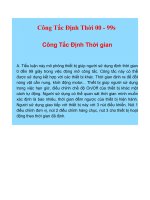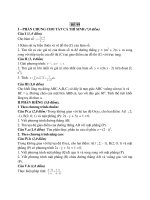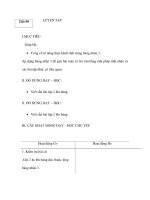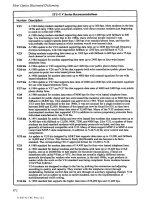C654 99
Bạn đang xem bản rút gọn của tài liệu. Xem và tải ngay bản đầy đủ của tài liệu tại đây (26.2 KB, 4 trang )
Designation: C 654 – 99
Standard Specification for
Porous Concrete Pipe1
This standard is issued under the fixed designation C 654; the number immediately following the designation indicates the year of
original adoption or, in the case of revision, the year of last revision. A number in parentheses indicates the year of last reapproval. A
superscript epsilon (e) indicates an editorial change since the last revision or reapproval.
This standard has been approved for use by agencies of the Department of Defense.
this specification as to design and freedom from defects.
5.2 The pipe shall be acceptable under the strength tests
when they have met the requirements as prescribed in Section
10.
5.3 Acceptance as to Infiltration Properties—Pipe shall be
acceptable under the infiltration test when all test pipe conform
to the test requirements as prescribed in Section 10.
1. Scope
1.1 This specification covers porous nonreinforced concrete
pipe for use in underdrains.
1.2 A complete metric companion to this specification has
been developed— 654M; therefore, no metric equivalents are
presented in this specification.
2. Referenced Documents
2.1 ASTM Standards:
C 33 Specification for Concrete Aggregates2
C 150 Specification for Portland Cement3
C 497 Test Methods for Concrete Pipe, Manhole Sections,
or Tile4
C 595 Specification for Blended Hydraulic Cements3
C 618 Specification for Coal Fly Ash and Raw or Calcined
Natural Pozzolan for Use as a Mineral Admixture in
Concrete2
C 822 Terminology Relating to Concrete Pipe and Related
Products4
C 1116 Specification for Fiber-Reinforced Concrete and
Shotcrete2
6. Materials
6.1 Concrete—The concrete shall consist of cementitious
materials and water.
6.2 Cementitious Materials:
6.2.1 Cement—Cement shall conform to the requirements
for portland cement of Specification C 150 or shall be portland
blast-furnace slag cement or portland-pozzolan cement conforming to the requirements of Specification C 595, except that
the pozzolan constituent in the Type IP portland–pozzolan
cement shall be fly ash.
6.2.2 Fly Ash—Fly ash shall conform to the requirements of
Specification C 618, Class F or Class C.
6.2.3 Allowable Combinations of Cementitious Materials—
The combination of cementitious materials used in the concrete
shall be one of the following:
6.2.3.1 Portland cement only,
6.2.3.2 Portland blast furnace slag cement only,
6.2.3.3 Portland pozzolan cement only, or
6.2.3.4 A combination of portland cement and fly ash.
3. Terminology
3.1 Definitions—For definitions of terms relating to concrete pipe, see Terminology C 822.
4. Classification
4.1 Pipe manufactured according to this specification shall
be of two classes identified as “Standard-Strength Porous
Nonreinforced Concrete Pipe” and “Extra-Strength Porous
Nonreinforced Concrete Pipe.”
NOTE 1—Porous pipe may experience leaching detrimental to durability when subjected to drainage of soft or acid waters (less than 50 ppm
hardness or less than 6.0 pH). Type V portland cement should be specified
where high sulfate resistance is required, and Type II or IIA portland
cement should be specified where the pipe will be exposed to moderate
sulfate conditions. More than 3000 ppm of chiefly sodium or magnesium
sulfates, or both, may be considered high sulfate content.
5. Basis of Acceptance
5.1 The acceptability of the pipe shall be determined by the
results of the strength and porosity or rate of infiltration tests,
and by inspection to determine whether the pipe conforms to
6.3 Aggregates—Aggregates shall conform to Specification
C 33 except that the requirement for gradation shall not apply.
6.4 Admixtures and Blends—Admixtures and blends may be
used with the approval of the owner.
6.5 Synthetic Fibers— Collated fibrillated virgin polypropylene fibers may be used, at the manufacturer’s option, in
concrete pipe as a nonstructural manufacturing material. Only
Type III synthetic fibers designed and manufactured specifically for use in concrete and conforming to the requirements of
Specification C 1116 shall be accepted.
1
This specification is under the jurisdiction of ASTM Committee C-13 on
Concrete Pipe and is the direct responsibility of Subcommittee C13.01 on
Reinforced Concrete Sewer, Drain, and Irrigation Pipe.
Current edition approved Aug. 10, 1999. Published September 1999. Originally
published as C 654–70T. Last previous edition C 654–95e1.
2
Annual Book of ASTM Standards, Vol 04.02.
3
Annual Book of ASTM Standards, Vol 04.01.
4
Annual Book of ASTM Standards, Vol 04.05.
Copyright © ASTM, 100 Barr Harbor Drive, West Conshohocken, PA 19428-2959, United States.
1
C 654
joined; and shall conform to all other requirements specified
for pipe of corresponding class and internal diameter, except
minimum infiltration. Joints shall be the same type as used in
the adjoining pipe.
9.3.2 Wyes and Tees— Fabricated branches for wyes and
tees shall be securely attached to the wall of the pipe and shall
be flush with the inside surface of the pipe.
7. Design
7.1 Design Tables— Design requirements shall be in accordance with Table 1 and Table 2 and Fig. 1. Wall thickness used
may be more than but not less than the value shown, except as
affected by the tolerance herein specified.
8. Joints
8.1 The joints shall be of such design and the ends of the
concrete pipe sections so formed that the pipe can be laid
together to make a continuous line of pipe compatible with the
permissible variations given in Section 7.
10. Physical Requirements
10.1 Test Specimen— The specified number of pipe required
for the test shall be furnished by the manufacturer and shall be
selected at random by the owner, and shall be pipe that would
not otherwise be rejected under this specification. The selection
shall be made at the point or points designated by the owner
when placing the order. The test pipe shall first be freed from
all visible moisture. When dry, each pipe shall be measured and
inspected. The results of these observations shall be recorded.
10.2 Number and Type of Test Specimens—The manufacturer shall furnish pipe for crushing tests, up to 0.5 % of the
number of pipe of each size included in the order, except that
in no case shall less than two pipes be furnished.
10.3 External Load Crushing Requirements—The crushing
strength of porous nonreinforced concrete pipe shall conform
to the requirements prescribed in Table 1 and Table 2. The
individual results of the various tests for each size of pipe and
for each shipment and plant shall be tabulated separately. The
crushing strength shall ordinarily be applied to not less than
75 % of the pipe received for purpose of test. All tests shall be
made in accordance with Test Methods C 497. Pipe shall be
acceptable when all test pipe conform to the specified strength
requirement. Should any of the test pipe provided in 10.2 fail
to meet the strength requirement, the manufacturer will be
allowed to test two pipe for each pipe that failed, and the pipe
shall be acceptable only when all of these additional test pipe
meet the strength requirement.
10.4 Infiltration Requirement—Infiltration (or porosity)
shall conform to the requirements in Table 1 or Table 2.
10.4.1 The test pipe shall be placed with a spigot end down
on a soft rubber nonpermeable mat, or its equivalent, and
weighted or clamped down if necessary to prevent the escape
of water through the spigot end of the pipe.
10.4.2 Water shall be introduced into the pipe, and the
distance above the bottom of the porous section at which the
water level becomes constant shall be determined. The rate of
flow shall be at least equal to the required minimum infiltration
9. Manufacture
9.1 Mixture—The aggregates shall be sized, graded, proportioned, and mixed with such proportions of cementitious
materials and water as will produce a homogeneous concrete
mixture of such quality that the pipe will conform to the test
and design requirements of this specification.
9.2 Curing—Pipe shall be subjected to any one of the
methods of curing described in 9.2.1 through 9.2.3, or to any
other method or combination of methods approved by the
owner that will give satisfactory results. The pipe shall be
cured for a sufficient length of time so that the concrete will
develop the specified strength requirement at 28 days or less.
9.2.1 Steam Curing— Pipe may be placed in a curing
chamber, free from outside drafts, and cured in a moist
atmosphere maintained by the injection of steam for such time
and at such temperature as may be needed to enable the pipe to
meet the strength requirements. The curing chamber shall be
constructed as to allow full circulation of steam around the
entire pipe.
9.2.2 Water Curing— Concrete pipe may be water-cured by
covering with water-saturated material or by a system of
perforated pipes, mechanical sprinklers, porous hose, or by any
other approved method that will keep the pipe moist during the
specified curing period.
9.2.3 The manufacturer may, at his option, combine the
methods described in 9.2.1 and 9.2.2 provided the specified
strength is attained.
9.3 Specials:
9.3.1 General Requirements—Special shapes or fittings
such as wyes, tees, bends, and adapters for use with concrete
pipe conforming to this specification shall be made of porous
or nonporous concrete in such manner as will provide strength
at least equal to the class of the adjacent pipe to which they are
TABLE 1 Physical and Dimensional Requirements of Porous Concrete Pipe
Internal Designated
Diameter, D
A
MinimumA Wall Thickness, Minimum Laying LengthA
T
Minimum Socket Depth,
Ls
Minimum Strength ThreeEdge-Bearing
Minimum Infiltration
in.
in.
in.
in.
lbf/ft
gal/min·ft
4
6
8
10
12
15
18
21
24
1
1
11⁄4
11⁄8
11⁄2
13⁄4
2
21⁄4
21⁄2
24
24
24
24
24
24
24
24
24
1
1
11⁄4
11⁄8
11⁄2
13⁄4
2
21⁄4
21⁄2
1000
1100
1300
1400
1500
1750
2000
2200
2400
4
6
8
10
12
15
18
21
24
Normally the minimum laying length is 24 in. in length, but if the owner has no objections, then 18-in. length pipe up to 12 in. in diameter may be supplied.
2
C 654
TABLE 2 Physical and Dimensional Requirements of Extra-Strength Porous Concrete Pipe
Internal Designated
Diameter, D
A
Minimum Wall
Thickness, T
Minimum Laying
LengthA
Minimum Socket
Depth, Ls
Minimum Strength
Three-Edge-Bearing
Minimum
Infiltration
in.
in.
in.
in.
lbf/ft
gal/min·ft
8
10
12
15
18
11⁄2
15⁄8
2
21⁄4
21⁄2
24
24
24
24
24
11⁄2
15⁄8
2
21⁄4
21⁄2
2600
2800
3000
3200
3200
8
10
12
15
18
Normally the minimum laying length is 24 in. in length, but if the owner has no objections, then 18-in. length pipe up to 12 in. in diameter may be supplied.
Note—See Table 1 and Table 2 for values of D, T,and Ls.
FIG. 1 Joint Dimensions
manufacturer will not be required to furnish equipment, facilities, nor personnel.
for 1 ft of pipe as given in Table 1 or Table 2.
10.4.3 The rate of infiltration per foot of pipe shall be
determined as follows:
11. Permissible Variations
11.1 Size and Dimensions—Pipe shall be furnished in the
sizes, internal diameters, and dimensions prescribed in Table 1,
Table 2, and Table 3 and Fig. 1.
11.2 Permissible variations from the dimensions described
in Table 1 and Table 2 shall not exceed those stated in Table 3.
This is not to be construed, however, that heavier wall
thickness pipe cannot be furnished at the option of the
manufacturer. Pipe intended to be straight shall not have
variation in alignment of more than 1⁄8in./ft of length.
GPM 5 g/h
where:
GPM = infiltration rate in gallons per minute per foot of
pipe,
g
= gallons per minute of flow introduced into the test
pipe, and
h
= height in feet from the bottom of the porous section
of the pipe at which the level of water becomes
constant.
10.5 Test Equipment— The manufacturer shall furnish all
equipment, facilities, and personnel necessary to perform at his
plant the tests specified in Section 10. In the event that the
owner elects to have tests performed at any other location, the
12. Repairs
12.1 Pipe may be repaired, if necessary, because of imperfections in manufacture or damage during handling and will be
TABLE 3 Permissible Variations in Dimensions of Porous Concrete Pipe
Limits of Permissible Variation
Internal Designated
Diameter,
A
Internal
Diameter,A
Length, Two
Opposite Sides
Wall Thickness,A
c
Length,
Depth of Socket,A
in.
in.
in.
in.
in./ft
in.
4
6
8
10
12
15
18
21
24
61⁄8
61⁄8
61⁄4
61⁄4
61⁄4
61⁄4
61⁄4
61⁄4
61⁄4
−1⁄16
−1⁄16
−1⁄16
−1⁄16
−1⁄16
−3⁄32
−3⁄32
−1⁄8
−1⁄8
⁄
1⁄4
5⁄16
3⁄8
3⁄8
7⁄16
1⁄2
9⁄16
9⁄16
−1⁄4
−1⁄4
−1⁄4
−1⁄4
−1⁄4
−1⁄4
−1⁄4
−1⁄4
−3⁄8
−1⁄8
−1⁄8
−1⁄4
−1⁄4
−1⁄4
−1⁄4
−1⁄4
−1⁄4
−1⁄4
14
The minus sign (−) indicates that the plus variation is not limited; the plus and minus (6) indicates variation in both excess and deficiency in dimension.
3
C 654
acceptable, if in the opinion of the owner, and the repaired pipe
conforms to the requirements of this specification.
considered cause for rejection unless these defects exist in
more than 5 % of the entire shipment or delivery.
14.1.2 The planes of the ends of the pipe are not perpendicular to the longitudinal axis, subject to the limits of variation
as shown in Table 3.
14.1.3 Defects that indicate mixing and molding not in
accordance with 9.1.
14.1.4 Cracks sufficient to impair the strength, durability, or
serviceability of the pipe.
13. Inspection
13.1 The quality of all materials, in the process of manufacture, and the finished pipe shall be subject to the inspection
and approval by the owner. Such inspection may be performed
at the point of manufacture or delivery.
14. Rejection
14.1 Pipe shall be subject to rejection on account of failure
to conform to any of the specification requirements. Individual
sections of pipe may be rejected because of any of the
following:
14.1.1 Fractures or cracks passing through the wall or joints,
except that a single crack not exceeding 2 in. in length at either
end of a pipe or a single fracture in the joints not exceeding 3
in. in width nor more than 2 in. in length shall not be
15. Marking
15.1 The letters “ES” shall be legibly stamped with waterproof ink, or other permanent matter, on all extra-strength
porous concrete pipe.
16. Keywords
16.1 concrete pipe; nonreinforced; porous; underdrains
The American Society for Testing and Materials takes no position respecting the validity of any patent rights asserted in connection
with any item mentioned in this standard. Users of this standard are expressly advised that determination of the validity of any such
patent rights, and the risk of infringement of such rights, are entirely their own responsibility.
This standard is subject to revision at any time by the responsible technical committee and must be reviewed every five years and
if not revised, either reapproved or withdrawn. Your comments are invited either for revision of this standard or for additional standards
and should be addressed to ASTM Headquarters. Your comments will receive careful consideration at a meeting of the responsible
technical committee, which you may attend. If you feel that your comments have not received a fair hearing you should make your
views known to the ASTM Committee on Standards, at the address shown below.
This standard is copyrighted by ASTM, 100 Barr Harbor Drive, PO Box C700, West Conshohocken, PA 19428-2959, United States.
Individual reprints (single or multiple copies) of this standard may be obtained by contacting ASTM at the above address or at
610-832-9585 (phone), 610-832-9555 (fax), or (e-mail); or through the ASTM website (www.astm.org).
4









